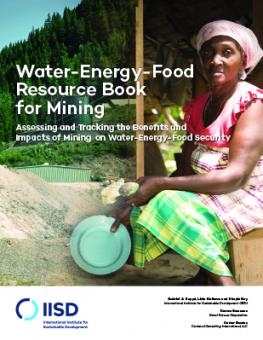
Water-Energy-Food Resource Book for Mining
This manual briefly explains IISD’s water-energy and food security framework.
Water, energy and food (WEF) security are interlinked and co-dependent components of security and ranked by the World Economic forum as a key global risk.
As attention to WEF security has grown, so has a need for practical means of implementing this complex, interlinked problem. The WEF security analysis tool (WEFsat-Mining) was developed as part of a multi-year initiative to operationalize a framework and implementation plan to assess WEF security, understand the impacts and implications of mining, and provide guidance to decision-makers on how to optimize across different priorities, including economic, social and environmental.
This manual briefly explains IISD’s WEF security framework. Informed by a comprehensive literature review, this framework enables a place-based analysis of four main components that focus the obvious and underlying factors affecting a community’s ability to be WEF secure: access, availability, supporting resources and supporting policies, and each in the context of a region’s water, energy and food supply. The WEFsat-Mining tool seeks to facilitate the operationalization of this framework in the context of mining with a focus on understanding and managing the benefits and impacts of mining on community-level WEF security. This guidance manual then walks the reader through a series of steps included in the WEFsat-Mining tool, including its 10 MS-Excel worksheets. These are: #1 Community profile; #2 WEF inventory base; #3 WEF Status base; #4 WEF diagram base; #5 Mine profile; #6 WEF inventory- mine; #7 WEF influence- mine; #8 WEF mine-composite; #9 WEF mine diagram; and #10 Executive Summary.
You might also be interested in
WEFsat-Mining Tool User-Guidance Manual: Water, energy and food security analysis tool for mining
Water-Energy-Food Security and Mining in Suriname: A project overview
Water, energy and food security constitutes critical components of human well-being and includes aspects of supply, demand and access to all three.
Water-Energy-Food Security: What are the potential contributions of the mining industry?
Senegal's Big LNG Gamble
This report explores Senegal's nascent liquefied nitrogen gas (LNG) industry by assessing the impacts associated with a new fossil fuel-based industry on the country's environment, economy, and society. It does this by responding to three questions: What have been the impacts of the development of LNG on Senegal to date? Is it viable for Senegal to invest further into an industry that is projected to decline? What risks can Senegal expect should it forge ahead with its LNG development plans?